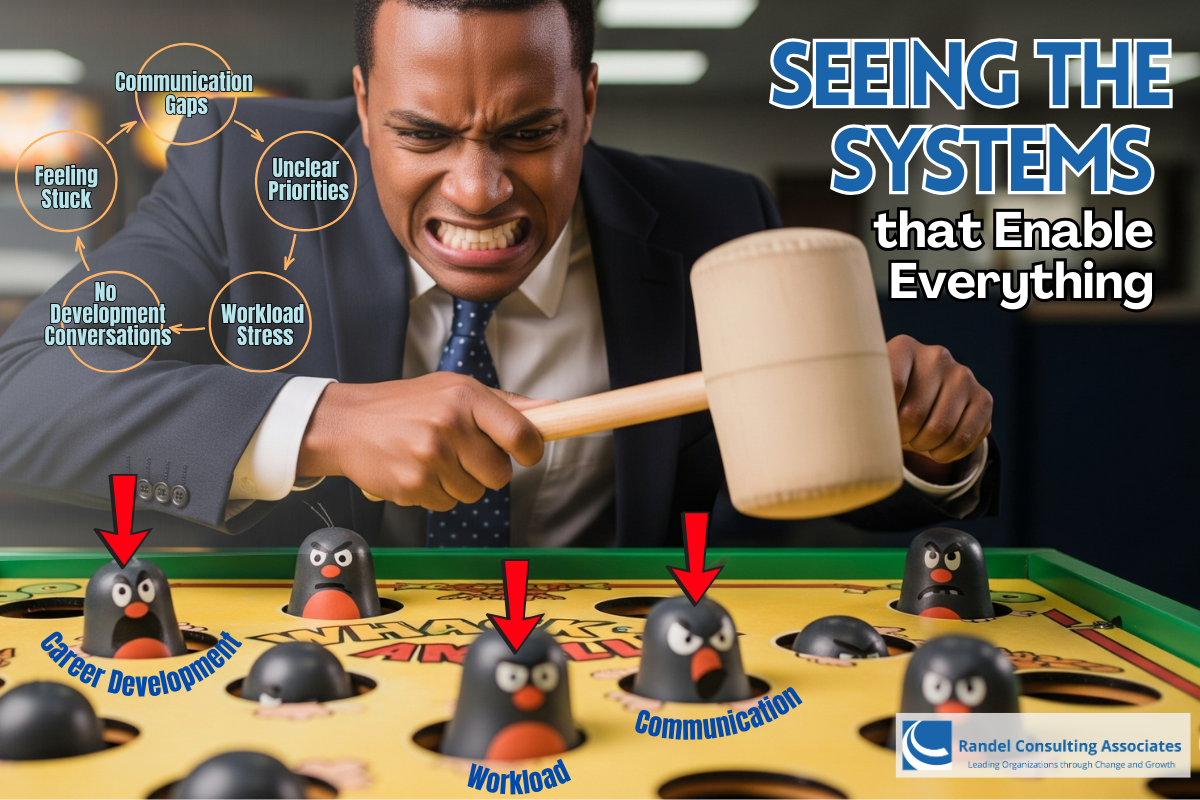How seeing systems reduces your overwhelm and increases your influence
Dear Change Leader,
“I kept thinking there had to be one key thing causing our retention problem,” explained David, a department head at a consulting firm. “I’d tackle communication, then discover it was workload. I’d address workload, then find out it was career development. Each solution seemed to create two new problems.”
For months, David had been playing organizational whack-a-mole, tackling symptoms one by one. Then, during a team retreat, someone mapped out how all these issues connected: communication gaps led to unclear priorities, which created workload stress, which left no time for development conversations, which made people feel stuck, which made them less likely to speak up about problems—completing the cycle.
“Once I could see the whole pattern,” David said, “I stopped trying to find the ‘real’ cause and started looking for the places where small changes could influence how the system behaves.”
From Linear Fixes to Systems Influence
David’s breakthrough builds on what we’ve explored in recent newsletters: asking better questions and seeking multiple perspectives. And there’s a third element that can transform how you approach complex challenges: seeing systems.
Most of us default to linear thinking—Problem A causes Problem B, so fix A and B disappears. However, organizational challenges rarely work this way. Instead, they exist within webs of relationships where multiple elements interact and influence one another, often in ways that aren’t immediately obvious.
Learning to “see systems” is a powerful leadership capability: it shifts you from feeling overwhelmed by complexity to finding strategic leverage points where small actions can create significant change.
The Leader’s Systems Lens
As you begin seeing systems, you’ll start to notice three things:
- Patterns Over Events: Instead of focusing on isolated problems, you become aware of recurring themes and cycles. David stopped asking “What’s wrong now?” and started asking “What pattern keeps repeating?”
- Connections Over Causes: Rather than hunting for the single root cause, you explore how different elements interact with each other. The retention issue wasn’t caused by any one factor—it was sustained by the interplay of multiple factors.
- Influence Points Over Control Points: You shift from trying to control outcomes directly to finding places where small changes can ripple throughout the system. David discovered that improving one team meeting structure influenced communication, workload clarity, and development conversations simultaneously.
Three Practices for Systems Awareness
Here are practical ways to develop your systems thinking as a leader:
- Daily Pattern Recognition
Each evening, spend five minutes asking: “What patterns did I notice today that I’ve seen before?” Look for recurring themes in meetings, repeated types of problems, or similar emotional dynamics across different situations.
This builds your pattern recognition muscles without requiring additional meetings or formal analysis.
- Weekly Connection Mapping
Once a week, choose one persistent challenge and spend 15 minutes sketching how it connects to other issues. Ask: “What does this problem depend on? What depends on this problem? Which conditions are reinforcing this challenge?”
You’re not ‘jumping into solutions’—instead, you are mapping the landscape so that you can navigate it more skillfully.
- Monthly Leverage Conversations
Each month, gather your team to create and explore a systems map together. Ask: “Where do we see opportunities to influence this system?” Look for points where you can strengthen the conditions you seek and weaken the ones you don’t.
These conversations help teams move from feeling stuck to identifying strategic intervention points.
Your Systems Breakthrough
This week, try applying systems thinking to one challenge that’s been frustrating you. Instead of asking “What’s causing this?” ask “What’s sustaining this pattern?” Instead of looking for the silver bullet solution, look for the small changes that could influence the way the system behaves.
Pay attention to what shifts when you move from linear problem-solving to systems influence. Often, the most effective interventions become visible only when you can see the whole pattern.
When everything connects to everything else, the goal isn’t to control all the connections—it’s to work skillfully with the ones that matter most.
Until next time,
P.S. Six months after the team’s retreat, David’s department was retaining more people and working more effectively together. Not because they solved every problem, but because they learned to work with the system’s own dynamics to create the changes they wanted.
Missed the earlier parts of this series?
- The Questions That Change Everything – Developing assumption-testing and perspective-expanding questions
- The Perspectives That Shift Everything – Moving beyond your leadership blind spots through multiple viewpoints
Real Leadership in Action
Beyond Solutions – How This Team Transformed From Within
What happens when a successful company realizes its internal culture doesn’t match the diverse markets it serves? This is what my client, the CEO of a 200-person financial services firm, discovered.
“We’ve built a successful business,” she explained, “but our internal culture doesn’t reflect the multicultural clients we serve. Our hiring, promotion, and service approach all stem from a limited worldview.”
Instead of looking for quick fixes, this CEO understood something crucial: lasting change would need to emerge from within the organization. She chose to influence how the system behaved, strengthening desired behaviors and weakening those that sustained the old culture.
The result? Over the course of two years, the company evolved into an organization where the preferred principles and practices permeate everything from hiring to performance management. Most importantly, they created internal systems that ensure this transformation continues.
Want to see how this CEO’s systems approach created lasting cultural change? [Learn more about her story and discover how seeing systems enables transformational change→]
Sometimes the most sustainable changes happen when leaders learn to see how systems are working and leverage opportunities to engage change.
EFFECTIVE CHANGE RESULTS FROM INTENTIONAL LEADERSHIP
We’re a leadership and organization development consultancy. My team and I work with leaders like you to prepare for and lead successful change processes.
Here’s why our clients call us:
- Leadership Coaching: I support leaders as they navigate transitions into new roles or expanded responsibilities.
- Group Coaching and Learning Programs: Bringing groups of leaders together, I facilitate learning experiences and months-long programs that equip people to be effective change leaders.
- Effective Teams and Stronger Organizations: I work with leaders and their teams with tailored processes that increase their effectiveness, building layers of aligned teams that transform organizations.


